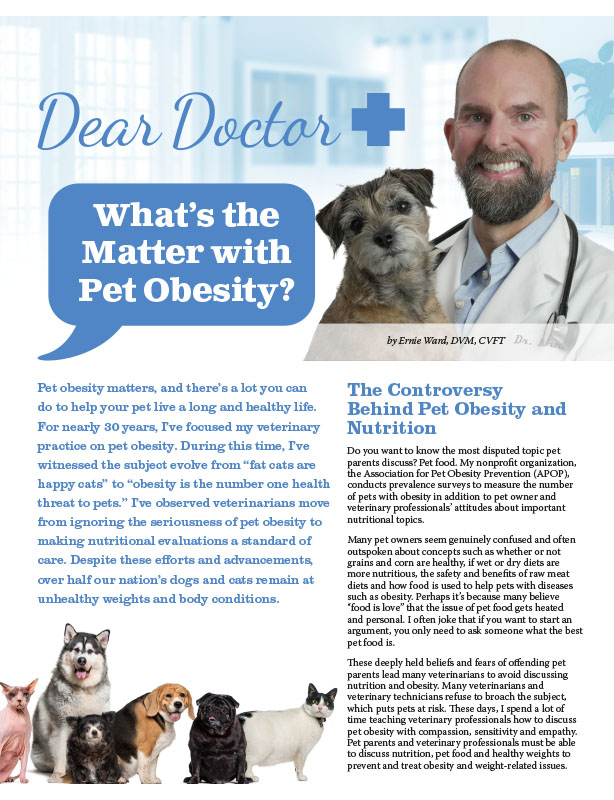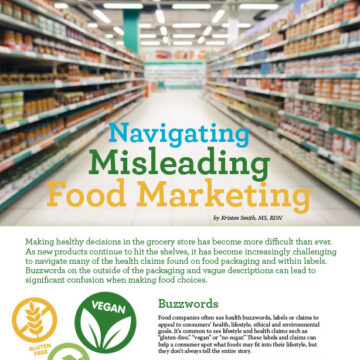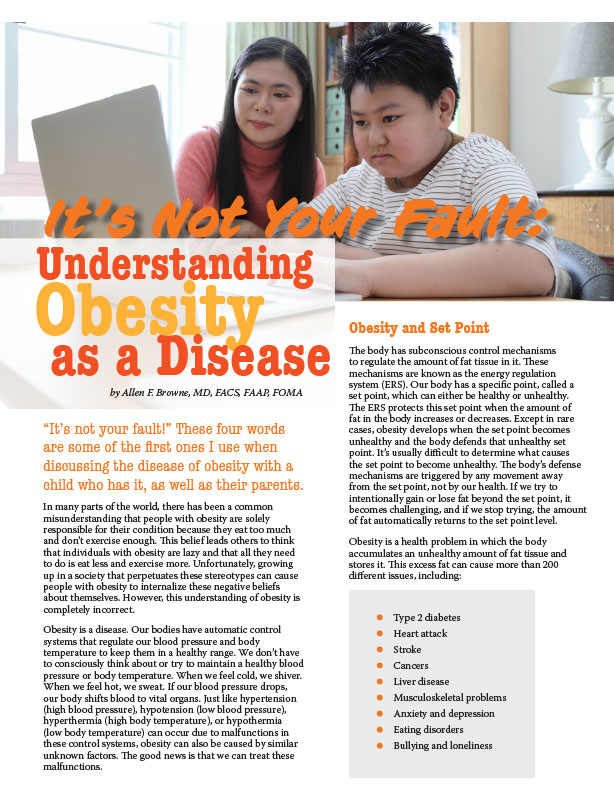Dear Doctor: What’s the Matter with Pet Obesity?


by Ernie Ward, DVM, CVFT
Spring 2023
Pet obesity matters, and there’s a lot you can do to help your pet live a long and healthy life. For nearly 30 years, I’ve focused my veterinary practice on pet obesity. During this time, I’ve witnessed the subject evolve from “fat cats are happy cats” to “obesity is the number one health threat to pets.” I’ve observed veterinarians move from ignoring the seriousness of pet obesity to making nutritional evaluations a standard of care. Despite these efforts and advancements, over half our nation’s dogs and cats remain at unhealthy weights and body conditions.
The Controversy Behind Pet Obesity and Nutrition
Do you want to know the most disputed topic pet parents discuss? Pet food. My nonprofit organization, the Association for Pet Obesity Prevention (APOP), conducts prevalence surveys to measure the number of pets with obesity in addition to pet owner and veterinary professionals’ attitudes about important nutritional topics.
Many pet owners seem genuinely confused and often outspoken about concepts such as whether or not grains and corn are healthy, if wet or dry diets are more nutritious, the safety and benefits of raw meat diets and how food is used to help pets with diseases such as obesity. Perhaps it’s because many believe “food is love” that the issue of pet food gets heated and personal. I often joke that if you want to start an argument, you only need to ask someone what the best pet food is.
These deeply held beliefs and fears of offending pet parents lead many veterinarians to avoid discussing nutrition and obesity. Many veterinarians and veterinary technicians refuse to broach the subject, which puts pets at risk. These days, I spend a lot of time teaching veterinary professionals how to discuss pet obesity with compassion, sensitivity and empathy. Pet parents and veterinary professionals must be able to discuss nutrition, pet food and healthy weights to prevent and treat obesity and weight-related issues.
Pet obesity and weight-related issues are complicated, often requiring patience and multiple interventions to treat successfully. To complicate matters, many pet parents and veterinary professionals think of pet obesity as being caused exclusively by poor feeding or lack of exercise. Few consider obesity to be a complex disease that is influenced by genetics, environment, individual physiology and other factors. Many shrug or abandon their efforts when a pet fails to lose weight after changing food or going on walks.
Unfortunately, veterinarians have few treatment options to recommend other than changes in diet and lifestyle. We lack medications or surgical interventions to assist a dog or cat in achieving a healthy body condition. That’s not to say diet and exercise don’t work; it just makes effectively treating pet obesity more challenging.
Pet Weight-loss Requires Both Art and Science
When offering evidence-based nutrition advice, we need to accept that pet nutrition is as much art as it is science. Even though our understanding of canine and feline physiology is greater today than 50 years ago, we’re still unable to precisely tailor nutrition to an individual pet (or person). We apply general beliefs about digestion, metabolism and biology in various combinations until we find the perfect food fit. Sometimes, we get lucky when our first diet and activity recommendation strikes weight-loss gold. Other times, the pet is still accumulating weight six months later. This leads me to my first bit of pet weight-loss advice: be patient, flexible and creative.
Pet Weight-loss Requires Patience, Flexibility and Creativity
For pet owners, I recommend ruling out medical conditions, getting guidance from a veterinarian and getting the whole family on board. Cat weight-loss, if too rapid, can result in serious health risks, including a life-threatening liver failure known as hepatic lipidosis.
The first element of this treatment ethos is to give change time. When adjusting a pet’s diet, activity or lifestyle, I teach veterinary professionals to “check for a change in 90 days.” Too often, veterinarians and pet owners are looking for instant results. If a 22-pound cat doesn’t lose two pounds in two weeks or a 100-pound Lab fails to shed five, we tend to declare failure and switch approaches (or the pet parent gives up in frustration). That’s a mistake in most cases.
The mammalian body is a master of physiological adaptation. If you cut calories or increase activity too fast, the body responds with systemic shifts, metabolic plateaus and behavioral outcries. If it were simple, we wouldn’t continue to diagnose so many pets and people with obesity.
Bottom line: you have to give change time to work. And for weight-loss, that’s about 90 days.
Patience
Ninety days is a realistic and reliable indicator of whether or not a weight-loss strategy works for most pets. If we check too soon, we may fail to allow a healthy adaptation. If we check too late, we miss an opportunity to intervene. A good place to start is to schedule the first veterinarian recheck after two to three months, unless there are medical conditions with your pet’s heart, thyroid, blood pressure, respiratory system or joints.
Flexibility
Flexibility in treatment is critical to pet weight-loss success. I can’t tell you the number of patients I’ve seen feeding the same “prescription diet” for a year or more, despite their pet failing to lose weight. If it’s broken, fix it.
Creativity
We treat individuals, not averages.
For successful weight-loss, you often have to become creative and open-minded. Being “dogmatic” in a pet weight-loss program is problematic. I’ve seen many dogs and cats respond to low-calorie, higher-protein and fiber formulations that initially failed on low-calorie, lower-protein, higher-fiber diets. Sometimes it’s added exercise, supplements, or weighing each meal that moves the needle.
Of course, I have a preferred initial weight-loss approach. If it doesn’t yield positive results, I try something else to find the right solution for the individual pet. Sometimes I must try two or three combinations of diet, exercise and supplements before seeing noticeable changes in body composition. And then we often have to change again as metabolic adaptations occur.
This “outcome uncertainty” is the most frustrating part of treating obesity for many veterinarians and pet parents. We prefer absolutes, direct actions and predictable effects. Rarely do these apply to pet nutrition and weight-loss efforts. To overcome plateaus and poor results, always be willing to get creative and work closely with your veterinary healthcare team.
Home Pet Body Condition Checkup
Curious if your pet needs to shed a few pounds? Try these at-home tests.
- Rib Run
You should easily feel your pet’s ribs under a thin layer of skin. If you’re pushing through a layer of fat that prevents you from feeling their ribs, chances are your pet is too heavy.
- Tummy Test
Does your dog or cat’s tummy sag and dip toward the floor? Be sure not to confuse a cat’s primordial pouch, a normal skin flap meant to hang down, with abdominal fat. Sorry, doggos — no such excuse for you. Pets with a healthy body condition will have an underbelly that is taut, tight and trends upward instead of dragging down.
- Waist Watch
When you look down at your pet, you should see a subtle hourglass silhouette instead of a round shape without any definition in the waist.
The Journey Begins
Ultimately, your veterinarian will create a nutrition plan to help your pet safely and successfully reach a healthy body condition. Make sure you understand how many daily calories your pet needs. Should you measure or weigh your pet’s meals? (I prefer weighing.) Ask about proper feeding and treating strategies, the role of “people foods” in the plan, and so on. I also recommend keeping a food, treat and exercise journal to track your actions. Whatever you do, strive to include your entire family. Too often, I’ve seen a pet’s health journey get sidetracked because of a careless family member.
There’s a lot that matters with pet obesity. While there are many questions you need answered by your veterinarian, your pet’s diet and body condition should be discussed during every exam. The few minutes you spend on food and weight could be the key to gaining additional years of life and love. That’s why pet obesity matters a lot.
About the Author:
Ernie Ward, DVM, CVFT, is an award-winning veterinarian, internationally known speaker, impact entrepreneur, author of several books, columnist and media personality. A 1992 graduate of the University of Georgia, he was voted Speaker of the Year at both VMX and WVC conferences, the 2018 Veterinary Journalist of the Year, and has received many veterinary and civic recognitions throughout his career. Dr. Ward currently serves as Veterinary Medical Lead for Basepaws by Zoetis and as Founder and President of the Association for Pet Obesity Prevention.
by Kelli Richardson, RD You’ve probably heard the generic advice before: Eat your fruits and veggies. Limit…
Read Articleby Allen F. Browne, MD, FACS, FAAP, FOMA Summer 2023 “It’s not your fault!” These four words…
Read Articleby Rachel Engelhart, RD; Kelly Donahue, PhD; and Renu Mansukhani, MD Summer 2023 Welcome to the first…
Read Article








